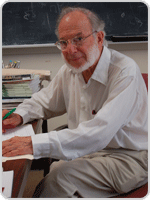- Details
-
Published: Friday, September 14 2012 01:00
Condensed Matter Lecture Set for Oct. 16 at UMD
COLLEGE PARK, Md. -- Nobel Laureate Andre Geim of the University of Manchester, UK, has been named the 2012 recipient of the Richard E. Prange Prize and Lectureship in Condensed Matter Theory and Related Areas. Dr. Geim will receive a $10,000 honorarium and deliver a public presentation entitled "Random Walk to Graphene” at the University of Maryland, College Park, on Oct. 16, 2012. He was awarded the 2010 Nobel Prize in physics with Konstantin Novoselov “for groundbreaking experiments regarding the two-dimensional material graphene”. Graphene, a single layer of carbon atoms arranged in a hexagonal lattice, exhibits tremendous stability, strength and electrical conductivity. Geim and Novoselov isolated the substance by using Scotch tape to peel it from graphite.
The Prange Prize, established by the UMD Department of Physics and Condensed Matter Theory Center (CMTC), honors the late Professor Richard E. Prange, whose distinguished professorial career at Maryland spanned four decades (1961-2000). The Prange Prize is made possible by a gift from Dr. Prange's wife, Dr. Madeleine Joullié, a Professor of Chemistry at the University of Pennsylvania
Born in Sochi, Russia, Dr. Geim did his undergraduate work at the Moscow Institute of Physics and Technology (Phystech) and received his doctorate at the Institute of Solid State Physics of the Russian Academy of Sciences. After appointments in the UK, Denmark and the Netherlands, he accepted a position as a professor of physics at the University of Manchester in 2001. In addition to his Nobel Prize, he has received the Mott, Europhysics and Korber prizes, the John J. Carty Award for the Advancement of Science from the U.S. National Academy of Sciences, and the Hughes Medal of the Royal Society. He currently holds the Langworthy and Royal Society 2010 Anniversary Research professorships at Manchester and directs its Centre for Meso-science and Nanotechnology. His Prange Prize lecture will be delivered at the University of Maryland's John S. Toll Physics Building at 4:00 p.m. on Tuesday, Oct. 16 in the Lecture Hall, Room 1412. The event is open to the public. Dr. Geim will also present a seminar entitled “Beyond Graphene” on Monday October 15 at 2pm in Room 1201 in the Maryland physics department.
While pursuing his doctorate at the University of Chicago, Richard Prange worked with Nobelist Yoichiro Nambu, among others. At the University of Maryland, he edited a highly-respected book on the quantum Hall effect and made important theoretical contributions to the subject. His interests extended into all aspects of theoretical physics, and continued after his retirement. Dr. Prange was a member of the Maryland condensed matter theory group for more than 40 years and was an affiliate of CMTC since its inception in 2002.
"Richard spent the very last afternoon of his life in the physics lecture hall for a colloquium on graphene,” said Dr. Joullié. "Afterward, he enjoyed a vigorous discussion on the topic. And so Andre Geim’s discussion of graphene could not be a better fit for the Prange Prize.”
"The Prange Prize provides a unique opportunity to acknowledge transformative work in condensed-matter theory, a field that has proven to be an inexhaustible source of insights and discoveries in both fundamental and applied physics,” said Dr. Sankar Das Sarma, who holds the Richard E. Prange Chair in Physics at UMD and is also a Distinguished University Professor and Director of the CMTC.
Since its initiation in 2009, the Prange Prize has been awarded to Nobelists Philip W. Anderson, Walter Kohn and Daniel Tsui.
###
Directions to the College Park campus can be found here: http://www.cvs.umd.edu/visitors/maps.html
To locate the Physics Building, see the campus map at: http://www.cvs.umd.edu/downloads/campus%20map%20012309.pdf .
University of Maryland Physics: http://umdphysics.umd.edu/ Weekly colloquia: http://www.umdphysics.umd.edu/events/physicscolloquia.html
College of Computer, Mathematical and Natural Sciences: http://www.cmns.umd.edu/
Condensed Matter Theory Center: http://www.physics.umd.edu/cmtc/

